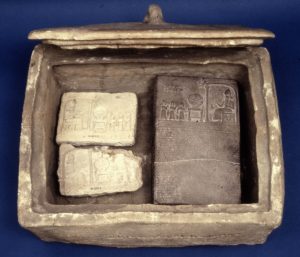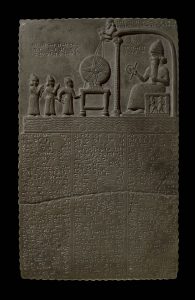This marvelous limestone tablet was excavated in 1881 in ancient Sippar, near modern Baghdad. The context it was found in is recreated in I.: The tablet was stashed away in a terracotta box; this box curiously being younger than the tablet itself. Inside there were also two clay casts of the relief on the Sun-God Tablet itself.

The Sun-God Tablet (or Tablet of Šamaš) contains a scene sculptured in relief at the head of the tablet, which depicts the King Nabu-apla-iddina being led by the priest Nabu-nadin-šumi and a goddess into the presence of the Babylonian God of Sun and Law, Šamaš. Said God is seated on a throne decorated with bullheaded humans, clad in a flowing robe, adorned with a horned crown, the symbol of divinity. Before the god is his symbol, the solar disc, resting upon an altar which is supported by ropes held by attendant deities, whose bodies spring from the roof of the shrine. In the field above the Sun-god are a lunar disc, a solar disc and an eight-pointed star, the symbols of Sin, Šamaš and Ištar, respectively.

The middle-babylonian inscription is engraved in six columns, three upon the obverse and three upon the reverse. It contains a record of Nabû-apla-iddina's re-endowment of the Sun-Temple at Sippar, after regular sacrifices and rites had been neglected. The text tells of the destruction of the cult statue of Šamaš by enemies under an earlier king. After consulting the god through oracle about the restoration of his statue, permission is not obtained and so this earlier king orders a replacement to be fashioned. This replacement is a sun disk, the symbol of Šamaš, which is arguably what is depicted in the relief. During the reign of King Nabû-apla-iddina, the Sun God looks upon him more favourably and lets a relief of his statue be found on the shores of the Euphrates. The high priest of Šamaš, Nabû-nadin-šumi, the one that happende upon the relief, reports it to the king, who orders a new statue to be made. After this, king Nabû-apla-iddina reinstates the apropriate sacrifices and rites that had been neglected by his predecessor.
cf. https://www.britishmuseum.org/research/collection_online/collection_object_details.aspx?objectId=282224&partId=1
Further reading:
K. Hecker (2011), Der wiedergefundene Sonnengott, TUAT NF 6, 36-40.
C. E. Woods (2004), The Sun-God Tablet of Nabû-apla-iddina Revisited, JCS 56, 23-103.
